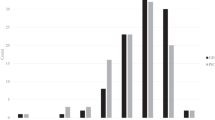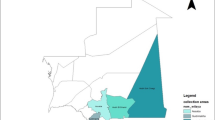Abstract
Over the past three centuries, maize has become adapted to complex environmental conditions in the highlands of Ethiopia. We analyzed 62 traditional Ethiopian highland maize accessions, using 20 simple sequence repeat (SSR) markers and 15 morphological traits, to assess genetic diversity and relationships among these accessions and to assess the level of correlation between phenotypic and genetic distances. The accessions varied significantly for all of the measured morphological traits. The average number of alleles per locus was 4.9. Pair-wise genetic dissimilarity coefficients ranged from 0.27 to 0.63 with a mean of 0.49. Ward minimum variance cluster analysis showed that accessions collected from the Northern agroecology were distinct from the Western and Southern agroecologies. However, there was no differentiation between the Western and Southern accessions. This suggested gene flow between these regions. The relationship between morphological and SSR-based distances was significant and positive (r = 0.43, p = 0.001). The high genetic diversity observed among these set of accessions, suggests ample opportunity for the development of improved varieties for different agroecologies of Ethiopia. From conservation perspective, sampling many accessions from all agroecologies would be an effective way of capturing genetic variation for future collections and conservation.
Similar content being viewed by others
References
J.F. Barbosa-Neto, C.M. Hernandez, L.S. O’ Donoughue and M.E. Sorrells, Precision of genetic relationship estimates based on molecular markers. Euphytica 98 (1997) 59-67
Beyene Y., Botha A.M. and Myburg A.A. 2005. Phenotypic diversity for morphological and agronomic traits in traditional Ethiopian highland maize accessions. S. Afr. J. Plant and Soil 22: 100–105.
T.P. Bogyo, E. Porceddu and P. Perrino, Analysis of sampling strategies for collecting genetic material. Econ. Bot. 34 (1990) 11-86
Agricultural Sample Survey 2000/2001 on Area Production of Major Crops, Private Peasant Holdings ‘Meher’ Season. Addis Ababa, Ethiopia: Statistical Bulletins 190 (2001).
Research Strategy Plan for Maize. Ethiopia: Addis Ababa (2000).
P. Dubreuile, P. Dufour, E. Krejet, M. Causse, D. de Vienne, A. Gallais and A. Charcosset, Organization of RFLP diversity among inbred lines of maize representing the most significant heterotic groups. Crop Sci. 36 (1996) 790-799
J. Felsenstein, PHYLIP (Phylogeny Inference Package) Version 3.5c. Distributed by the Author. SeattleWashington: Department of Genetics, University of Washington (1993).
H. Jerry, Number Cruncher Statistical Systems (NCSS). KaysvilleUtah: Statistical software (2000).
H.P. Hafnagel, Agriculture in Ethiopia. Rome: FAO (1961).
Z.E. Henandez, Maize and man in the greater Southwest. Econ. Bot. 39 (1985) 416-430
N. Mantel, The detection of disease clustering and a generalized regression approach. Cancer Res. 27 (1967) 209-220
Y. Matsuoka, S.E. Mitchell, S. Kresovich, M. Goodman and J. Dobeley, Microsatellite in Zea – variability, patterns of mutations and use for evolutionary studies. Theor. Appl. Genet. 104 (2002) 436-450
R.W. Michelmore, I. Paran and R.V. Kessli, Identification of markers linked to disease resistance genes by bulked segregant analysis: a rapid method to detect markers in specific genomic regions using segregant populations. Proc. Natl. Acad. Sci. USA 88 (1991) 9828-9832
A.A. Myburg, D.L. Remington, D.M. O’ Malley, R.R. Sederoff and R.W. Whetten, High-throughput AFLP analysis using infrared dye-labelled primers and an automated DNA sequencer. BioTechniques 30 (2001) 348-357
NMSA (National Meteorology Service Agency). 2000. Monthly Weather ReportFebr. 1980 to Dec. 2000. Addis AbabaEthiopia.
M. Nie and W.H. Li, Mathematical model for studying genetic variation in terms of restriction endonucleases. Proc. Natl. Acad. Sci. USA 76 (1979) 5269-5273
L.R. Pinto, M.L.C. Vieira, C.L.P. de Souza and A.P. de Souza, Genetic diversity assessed by microsatellites in tropical maize populations submitted to a high-intensity reciprocal recurrent selection. Euphytica 134 (2003) 277-286
C. Rebourg, B. Gouesnard and A. Charcosset, Large scale molecular analysis of traditional European maize populations. Relationships with morphological variation. Heredity 86 (2001) 574-587
L. Roldan-Ruiz, F.A. Van Eeuwijk, T.J. Gilliland, P. Dubreuil, C. Dillmann, J. Lallemand, M. Loose De and C.P. Baril, A comparative study of molecular and morphological methods of describing relationships between perennial ryegrass (Lolium perenne L.) varieties. Theor. Appl. Genet. 103 (2001) 1138-1150
M.A. Saghai-Maroof, R.M. Biyashev, G.P. Yang, Q. Zhang and R.W. Allard, Extraordinarily polymorphic microsatellite DNA in barely: species diversity, chromosomal locations and population dynamics. Proc. Natl. Acad. Sci. USA 91 (1994) 5466-5470
M.L. Senior and M. Heun, Mapping maize microsatellites and polymerase chain reaction conformation of the targeted repeats using a CT primer. Genome 36 (1993) 884-889
M.L. Senior, J.P. Murphy, M.M. Goodman and C.W. Stuber, Utility of SSRs for determining genetic similarities and relationships in maize using an agarose gel system. Crop Sci. 38 (1998) 1088-1098
J.S.C. Smith and O.S. Smith, Fingerprinting crop varieties. Adv. Agron. 47 (1992) 85-140
S Twumasi-Afriyie, Z Habatmu, Z Kassa, Y Bayisa and T Sewagegn, Development and improvement of highland maize in Ethiopia. 2nd National Maize Workshop of Ethiopia. Ethiopia: Addis Ababa (2001).
M.L. Warburton, X. Zianchun, J. Crossa, J. Franco, A.E. Melchinger, M. Frisch, M. Bohn and D. Hoisington, Genetic characterization of CIMMYT inbred maize lines and open pollinated populations using large scale fingerprinting methods. Crop Sci. 42 (2002) 1832-1840
J.H. Ward, Hierarchical grouping to optimize an objective function. Am. Stat. Assoc. J. 56 (1963) 236-244
Author information
Authors and Affiliations
Corresponding author
Rights and permissions
About this article
Cite this article
Beyene, Y., Botha, AM. & Myburg, A.A. Genetic Diversity Among Traditional Ethiopian Highland Maize Accessions Assessed by Simple Sequence Repeat (SSR) Markers. Genet Resour Crop Evol 53, 1579–1588 (2006). https://doi.org/10.1007/s10722-005-8509-y
Received:
Accepted:
Published:
Issue Date:
DOI: https://doi.org/10.1007/s10722-005-8509-y




